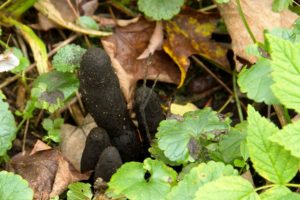
Dead Man’s Fingers
Nature has so much to offer this time of year – fascinating animal movements, beautiful leaf colors, renewed opportunities for hiking, hunting, and fishing. There are fewer mosquitoes and comfortable temperatures are icing on the cake.
There is so much to see on a hike in the forest now – some plants are just starting to bloom, while others are senescing- dying back at the end of their growing season. What was hardly noticeable when there was so much green now stands out- mosses and clubmosses, evergreen ferns and trees, lichens etched into trunks in a multitude of different forms.
Usually unseen but so abundant this year are the fruits of the fungi- mushrooms. Although I am no expert, I still appreciate and marvel at these interesting and sometimes weird reproductive structures of subsurface life forms. We think in terms of plant and animal kingdoms of organisms, but fungi are neither- they are members of their own kingdom and there are a lot of them. Some fungi are single celled – like yeasts and molds. Others are huge and unbelievably complex, growing in the soil and encompassing acres in area.
For mushrooms, there are two main parts- the permanent and the temporary. The subsurface parts are more permanent and consist of threadlike mycelium which wind through soil or plant material like wood. They help to decompose organic matter into nutrients which can be used by other organisms. Sometimes fungi work in cooperation with plants, intertwining with roots. Trees and wildflowers, especially orchids, benefit from certain fungi in the soil. Plants in the pea family also have these strong relationships. For trees, the relationship may be even more intimate- there are fascinating studies about fungi having a role in the ability of trees to communicate with each other through their roots, but that is unseen and hard to comprehend.
What is delightful is the eruption of spore-producing mushrooms, as varied and colorful as flowers… or not. One of the most interesting and creepy mushrooms is called Dead Man’s Fingers. These narrow, gray mushrooms emerge from the soil in a group or line and look as though a body had been buried and a zombie is trying to claw it’s way back to the surface! Others have equally interesting forms, and names to match- witch’s butter, artist’s pallette, shaggy mane, fly agaric, giant puffball, turkey tail, hen of the woods (which looks nothing like a chicken), and hundreds of others. Our moist summer and fall must have favored the fungi because many mushrooms seem to be present this year.
Some people go hunting, some people go birding, and, yes, some of us go mushrooming to see how many different ones we can find. A walk with a mushroom field guide can be an interesting and rewarding experience for families. I remember spending hours in the woods watching my daughter photograph mushrooms, one of our best hikes ever.
Some mushrooms are very tasty as well, but if you call the nature center we’re not going to give you advice on that. Some of the most attractive mushrooms are very toxic, and there are lookalikes that could be safe or unsafe. I limit my foraging to my own property and stick to a couple of species that I am confident I can identify. If you choose to eat them, be sensible about it.
Fungi are an extra adornment to an already beautiful forest. They are a bonus that make the natural world even more interesting.
photo- creepy Dead Man’s Fingers mushroom by Nancy Nabak of our staff
